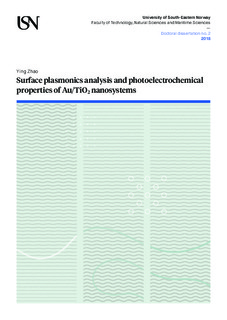Surface plasmonics analysis and photoelectrochemical properties of Au/TiO2 nanosystems
Doctoral thesis
Permanent lenke
http://hdl.handle.net/11250/2498991Utgivelsesdato
2018Metadata
Vis full innførselSamlinger
Sammendrag
This thesis focuses on investigation of photoelectric and photoeletrochemical (PEC) performance of TiO2 nanotube based photoelectrodes. Surface plasmonic resonance (SPR) have been studied by theoretical analysis, fabrication and optimization of nanocrystallines Au on TiO2 nanotube arrays for facilitating both photoactivity andcarrier transfer.
Numerical analysis of surface plasmonic resonance on different Au/TiO2 nanostructures is a focal point of the study. Finite element analysis was performed through electromagnetic wave module under frequency domain. Simulation results agree well with experimental results. Meanwhile, it is revealed by simulation that plasmonic Au-nanoring structure can originate deeper and more uniformly distributed near-surface electric field within TiO2 nanotubes as compared to Au-nanoparticles. Furthermore, a novel optical structure where Au nanodisks are embedded in titanium dioxide nanohole arrays was proposed based on analogous numerical study. Simulation demonstrates five to seven times light absorption enhancement at resonant wavelength of 700 - 800 nm despite of varied reception angles from 0 to 45 degrees. Broad absorption bandwidth is possible by varying the thickness of the embedded Au layer. Such structure will improve the optical absorption performance of TiO2 nanostructure in the visible light region while maintaining the UV absorption by TiO2 material. Fabrication process was introduced in theory to realize the nanostructure.
For experimental study, self-ordered TiO2 nanotubes were synthesized via electrochemical anodization with good control of dimension and phase. Au nanoparticles and nanoring structures were subsequently formed on TiO2 nanotubes via magnetron sputtering for different time intervals. Au-coated TiO2 photoanode exhibits extended light absorption spectrum to the visible light region. PEC measurement results indicate nearly three times accelerated charge transfer rate and four times enhanced photocurrent response after proper amount of Au coating. These improved performance of Au/TiO2 nanostructures are all attributed to surface plasmonic resonance which is generated at the interface of Au and TiO2. In addition, transient current response shows different ramp-up behaviour at the onset of illumination. Such distinct performance could be related to how the SPR-induced electric field is distributed in the vicinity of Au/TiO2 interface and how the charge carriers travel and recombine along the longitudinal dimension of the TiO2 layer.
Består av
Artkel 1: Zhao, Y., Hoivik, N., & Wang, K. (2016). Recent advance on engineering titanium dioxide nanotubes for photochemical and photoelectrochemical water splitting. Nano Energy, 30, 728-744. DOI: 10.1016/j.nanoen.2016.09.027Artikkel 2: Zhao, Y., Hoivik, N., Akram, M.N., & Wang, K. (2017). Study of plasmonics induced optical absorption enhancement of Au embedded in titanium dioxide nanohole arrays. Optical Materials Express, 7(8), 2871-2879. DOI: 10.1364/OME.7.002871
Artikkel 3: Zhao, Y., Hoivik, N., & Wang, K. (2018). Microstructure and photoelectric response of gold nanocrystalline on TiO2 nanotube arrays. The Journal of Physical Chemistry C, 122(14), 7877-7884. DOI: 10.1021/acs.jpcc.7b08608
Konferansebidrag, artikkel 1: Zhao, Y., Hoivik, N., & Wang, K. (2014). Study of TiO2 nanotube formation mechanisms by simulation on electric domain. ECS Transactions, 61(36), 9-13. DOI:10.1149/06136.0009ecst
Konferansebidrag, artikkel 2: Zhao, Y., Hoivik, N., & Wang, K. (2014). Photoconductivity of Au-coated TiO2 nanotube arrays. IEEE International Conference on Nanotechnology, Toronto, Canada, August 18-21. DOI: 10.1109/NANO.2014.6967993
